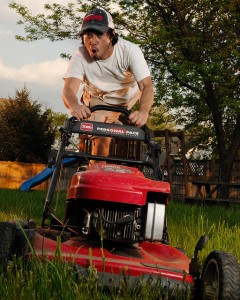Got any grass man?

No not that grass.
I am talking about turf. It’s that green stuff you see everywhere on flat surfaces. In my area it is usually a mix of Kentucky Bluegrass, Perennial Rye and Fescues.
You know the stuff that demands you ritually attend to it most every week from Spring to Fall.
The ritual begins in late April or May in my parts. It is performed by men, women and children across the country. Some find the ritual meditative. Others consider it a pain. It is much like any physical labor required around the house. If you have money you can get out from having to do it. It is mowing the lawn.
A Summer ritual

This pastime of summer is so entrenched in our lives, for many it feels strange if we don’t do it.
Some of us are a little more casual with our lawns. We may neglect fertilizing in the spring, so our grass grows slower than the neighbor’s golf course greens disguising itself as a front yard.
For us in the northern half of the country, we may not mow in the summer when our cool season grasses go dormant and turf that nice shade of straw.
But even us (alright I admit it), can’t totally escape the tyranny of the turf.
So more weeks than not, we shleep out to the garage or shed to get the mower.
Next week we will repeat it again. And again. And again.
At least until we get fed up and call in the paid reinforcements. Maybe the neighbor kid or a lawn service.
Its not only mowing it demands
It would be bad enough if we just had to cut it every week. Don’t forget the other stuff your lawn really wants.
- The spring fertilizing and crab grass preventer.
- Then the summer fertilizing and weed killer.
- Then the grub poison.
- We should (but probably won’t) de-thatch and aerate our lawn.
- Then overseed it.
- Then give it a fall fertilizer.
I am ready for a nap just thinking about it!
How did this obsession with grass begin?
Historians say the desire for lawns came about in 17th century Europe. The royal families flaunted their cash by surrounding their estates with lawns. Lawns do a great job of showing off castles! They also let everybody know that they were so wealthy that they could afford to use their land as a playground. Instead of how most people used it back then, as a source of food. The lawn became a status symbol of the wealthy.

In the United States, we were far too busy to be bothered with something as useless and time-consuming as a lawn. Well at least for a while.
By the mid 1800’s, Americans desire to act like crusty old wealthy Europeans was in full swing. Americans began seeing magazine articles promoting the lawn as a requirement for a beautiful home. Only the wealthy could afford the labor costs of maintaining lawns. This furthered the idea of lawn as a status symbol.
Then the push mower came on the scene in 1870 and suddenly almost any home owner who wanted a lawn could have one. It didn’t happen overnight.
Americans get suckered in
It took the cooperation of the Garden Clubs of America, U.S. Department of Agriculture, and U.S. Golf Association to spread the tyranny of the turf in the early 1900’s. Contests to reward home owners with the best lawns were begun. Slowly the desire to first impress and then conform to the neighbors started. Lawns were not an aesthetic choice but instead a moral imperative that compelled action (and mowing!).
After World War II, we got gasoline powered lawnmowers and potent chemicals turned into fertilizer and pesticides. This came at the perfect time during the post war boom, when Americans everywhere became suburbanites and felt they needed lawns.
So what?
Now you have to choose. You can either take the blue pill and the story will end. You will wake up in your bed and believe whatever you want to believe. And go on buying whatever Scott’s is selling you or…
You take the red pill and stay in Wonderland and I’ll show you another way next time.
Yes that was TWO outdated cultural references in one post!
Lacey says
What a tease! I’m not a grass or lawn person, so I can’t wait to read the rest.